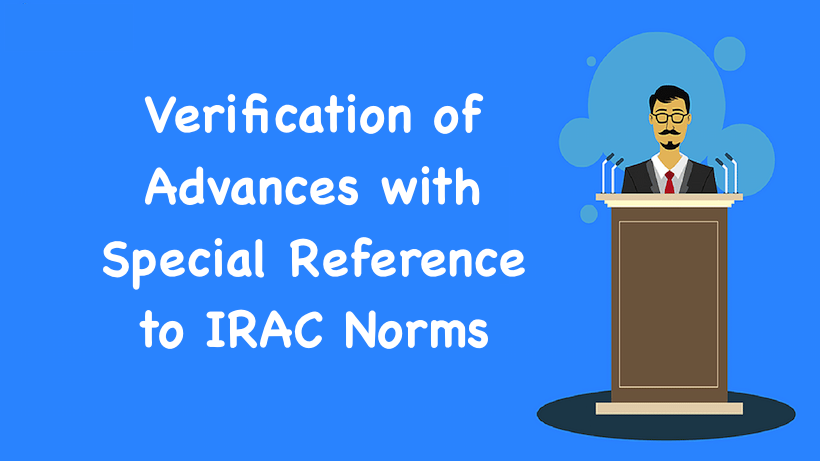Verification of Advances with Special Reference to IRAC Norms (Income Recognition and Asset Classification). Following is the Addendum to the article published about verification of advances with special reference to Income Recognition and Asset Classification (IRAC) Norms in February 2018 issue of The Chartered Accountant journal.
The RBI has issued a circular dated February 07, 2018 granting relief for MSME Borrowers registered under GST, thus, the auditors needs to be vigilant as regards the applicability of the said circular and eligibility of the borrower
Verification of Advances with Special Reference to IRAC Norms
This circular applies only to borrowers which are classified as micro, small and medium enterprise under the MSMED Act, 2006. The exposure of banks to such borrowers would be classified as standard assets subject to conditions specified in the circular:
- 1. The borrower is registered under the GST regime as on January 31, 2018;
- 2. The aggregate exposure including non-fundbased facilities of banks and NBFCs, to the borrower does not exceed R25 crores as on January 31, 2018.
Thus, the overall exposure of the borrower (including that of multiple banking, consortium banking) as on January 31, 2018 should not exceed Rs 25 crores, i.e. the overall exposure of the borrower to banks and NBFCs combined should not exceed the cap of Rs 25 crores. Further, it is to be noted that as per RBI Master Circular on Exposure Norms– ‘Exposure’ shall include credit exposure (funded and non-funded credit limits) and investment exposure (including underwriting and similar commitments). The sanctioned limits or outstandings, whichever are higher, shall be reckoned for arriving at the exposure limit. However, in the case of fully drawn term loans, where there is no scope for re-drawal of any portion of the sanctioned limit, banks may reckon the outstanding as the exposure.
“A provision of 5% shall be made against such exposures which are not classified as NPA (due to the relaxation as provided above), which otherwise would have been classified as NPA as per usual IRAC norms (of accounts overdue beyond 90 days period).”
The borrower’s account should be standard account as on August 31, 2017. It would be pertinent to note that some banks may be following a system of marking of accounts as NPA in the system as at quarter-end instead of marking the accounts on an on-going basis. However, the borrower account needs to be tested for classification purpose as on August 31, 2017 and in case if such account is a NPA account as per the extant of IRAC norms specified by RBI as on August 31, 2017, irrespective of the account being marked or not by the bank, such accounts will not be eligible for relief granted by this circular;
The amount from the borrower, overdue as on September 01, 2017 and payments from the borrower due between September 01, 2017 and January 31, 2018 are paid not later than 180 days from their respective original due date.
As per para 2.3 of Master Circular of RBI on IRAC norms– ‘any amount due to the bank under any credit facility is ‘overdue’, if it is not paid on the due date fixed by the bank’. Thus, the extension period of 180 days granted for the repayment of the overdue amount as on September 01, 2017 as well as the amounts due between the specified period is restricted to the extent of 180 days from the respective ‘due date’. The words ‘overdue’ as well as ‘due date’ mentioned in the said clause are significant, since both are applicable in case of facilities other than CC/OD like Term Loan, Bill Discounting, etc.
only and thus, are not relevant as far as CC/OD facilities are concerned as CC/OD accounts per se do not have the concept of ‘overdue’ but have concept of ‘overdrawn’ and, there is no ‘due date’ concept w.r.t. CC/OD account. Further, it is to be noted that a CC/OD account would qualify to be a NPA if the account remains ‘out of order’ as indicated in para 2.2 of the Master Circular of the RBI on IRAC Norms. Thus, the said extension granted is confined to the facilities which are other than CC/OD
A provision of 5% shall be made against such exposures which are not classified as NPA (due to the relaxation as provided above), which otherwise would have been classified as NPA as per usual IRAC norms (of accounts overdue beyond 90 days period).
The additional time provided is for the purpose of asset classification only and not for income recognition.
Thus, if an account is otherwise eligible to be classified as NPA as per usual IRAC norms (of accounts overdue beyond 90 days period) but is classified as PA based on the above-mentioned relaxation granted, the income is required to be recognised on realisation basis and not on accrual basis.
It is suggested that the readers should refer to Page 47 of the Chartered Accountant journal for the month of Feb’18 for the definition of ‘Overdue’ and norms applicable to various credit facilities. Stop print: The Reserve Bank of India has issued circular dated February 12, 2018 w.r.t. Resolution of Stressed Assets– Revised Framework’, which is not covered in the above article.
Recommended Articles







